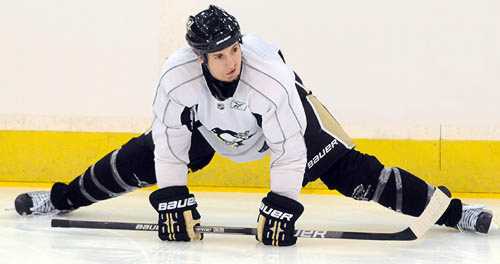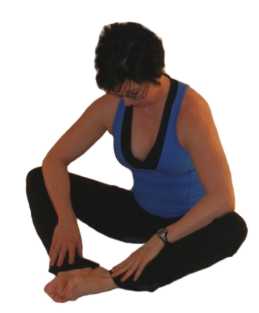Ice Hockey Exercises
Below is a series of ice hockey exercises to address common muscle imbalances that occur in hockey players. To go to Hockey Stretches immediately click here. Flexibility training will not only prevent injuries but will also improve your game. Because the game of hockey takes place on a virtually frictionless surface it is important to have core stability as well as flexibility. You can find core exercises here.
Contents
Why
should ice hockey exercises include stretching?
How
should hockey players stretch?
Stretching
Exercises for Ice Hockey
When
do hockey injuries occur?
What
type of injuries do hockey players sustain?
Who gets injured?
How does physical conditioning
affect rates of injury?
What
are the
main muscles used in hockey?
Stretching
exercises for ice hockey
Hockey
warmup and cool down

Why should ice hockey exercises include stretching
Stretching
should occur while off the ice and prior to practices and games to
improve a player's flexibility so that they can move more
freely, improve their level of performance, expend less energy during
movement, and is a fundamental part
of a good risk management program. Stretching benefits include:
- improved range of motion
- improved posture and mechanics
- increased strength
- better muscular relaxation
- improved movement efficiency
- better body awareness
- less muscle soreness
Ice Hockey exercises - How should hockey players stretch
- There should be a warm up before stretching.
- Each stretch must be held with proper body alignment during the stretch.
- Players should stretch to the point of resistance, not pain.
- Players should be in control of their stretch at all times
- static stretches done slowly
- dynamic on ice stretches should not be bouncy
- during range of motion exercises there should be no momentum and no bounce
- static stretches should be held for 15 to 30 seconds and repeated two to four times. Older players should hold these stretches a little longer.
- stretching should occur at the end of the game/practice as well as before.
- If any stretches cause pain, they should be stopped and medical advice sought.
While it is important to develop flexibility in the muscles
and joints in
hockey it is more important to be able to integrate this flexibility
into movements during hockey drills.
Flexibility in a young player will change with growth spurts
and this
should be accommodated during the stretching program. (usually about
age
12 for girls and 14 for boys)
Stretching is only one component of an adequate program of
ice hockey
exercises. A player's program and hockey drills must also address
components of aerobic
and anaerobic fitness, strength, and power.
When do hockey injuries occur
Injuries in
hockey occur more commonly in games rather than practices. (1) Injuries
more commonly occur during the final five minutes of a period, and 42%
of injuries occur in the third period of a game, usually exhibition
and preseason games. This is likely due to the level of competition
involved and player fatigue.
What type of injuries to hockey players sustain

Head
and face
injuries account for 42% of injuries
Upper body
injuries account for 27% of injuries
Lower body
injuries account for 31% of injuries

Junior A (16-20 years old)
Who gets injured

63% of injuries
are sustained by forwards
33% of injuries
are sustained by defense
4% of injuries
are found in goalies
Ice Hockey Exercises - How does physical conditioning affect rates of injury
Ice Hockey Exercises - What are the main muscles involved in playing hockey
Moving around on
a virtually
frictionless surface requires a lot of stability from which the
extremities must operate. The efficient transfer of energy from the
skates through the trunk requires a strong core. That
includes
the abdominal muscles of course, as well as multifidus, rotatores, and
the deep hip muscles such as the rotators and pectineus. Force
generated for a strong slap shot originates from the core
musculature.You need a stable core from which the large latissimus
dorsi, deltoid and pectoral to work from.
Gastrocnemius and soleus work to support the player
especially as wight
is shifted forward. Quadriceps and gluteus maximus are the powerful hip
and knee extensors required for a strong and rapid push off. Gluteus
medius is the main hip abductor used to support the pelvis in single
leg weight bearing, and the adductors are used to bring the leg back to
midline.
Ice Hockey Exercises - Stretching and Flexibility

Stretch
the Trunk and Shoulders
- Stand with your chest lifted up and feet shoulder width apart.
- To stretch the right side, bring your right elbow overhead
- Flex your trunk to the left side while pulling your elbow to the left and letting your hand slide down the centre of your back.
- Hold this stretch for 15 to 30 seconds depending on age.
- Be sure that you don't rotate your trunk while you are performing the stretch.
- Repeat this for the left side as well.
This stretches a number of muscles and tissues on the right
side:
- Triceps
- Latissimus dorsi
- Levator scapula
- Quadratus lumborum
- Intercostals
- Lower fibres of trapezius
- Also stretches fascia, interspinous ligaments, and shoulder and acromioclavicular joint capsules

Stretch the quadriceps in standing:
- Stand beside a wall so as to hold on with one hand if necessary to balance.
- Reach down and grab your right ankle. You can use the hand on the same side or the opposite side. Most people find using the opposite hand most comfortable because it allows the hip to stay in a comfortable position.
- Straighten your back, lift your chest up and pull your ankle back and up slowly.
- If you are able to bring your knee behind you as in the picture you can stretch rectus femoris as well.
- Hold this position for 15 to 30 seconds, repeat 2 to 4 times and then perform this stretch on the other leg.

Stretch the Hip Flexors
- Kneel on your right knee and put your left foot in front of you.
- Put your hand on your right hip
- Lean forward and push your right hip forward. You should feel this stretch in the front of your right hip.
- Hold this position for 15 to 30 seconds, repeat 2 to 4 times and then perform this stretch on the other side.

Adductors are stretched in
sitting.
- Sit on the floor with your knees apart and the bottom of your feet together.
- Keep your chest up and your back straight.
- Bend forward at the hips while accentuating your lumbar lordosis (keep pelvis tilted anteriorly)
- Apply gentle pressure to your knees pushing them toward the floor.
- Relax and hold this for 15 to 30 seconds, repeat 2 to 4 times.

Stretch your hamstrings in
sitting. If
you are able to maintain a straight lower back and anteriorly tilted
pelvis while performing this stretch it is significantly more
effective.
- To perform this stretch sit on the ground with your right leg stretched out in front of you and your left knee bent with foot facing your right knee.
- Keep your chest up and back straight.
- Bend forward at the hips until you feel a stretch in the back of your thigh.
- Hold this position for 15 to 30 seconds, repeat 2 to 4 times and then stretch the other leg.

This is a good stretch for both
hips.
- While lying on your back grab hold of your right knee and pull it up toward your chest.
- If you have knee pain doing this simply adjust your hold to the back of the thigh.
- Pull your right knee toward your chest while keeping your knee in alignment with the right shoulder.
- Push your left left down into the floor as you exhale, relax, and hold this for 15 to 30 seconds, 2-4 times.
- Repeat this on the other leg.
Ice Hockey Exercises for Warm Up and Cool Down
A warm up is necessary for all hockey players regardless of level to
prepare for the increase in demand metabolically and to prevent
injuries. The function of an adequate warm up is as follows:
- Reduce connective tissue resistance and therefore allow more freedom and range of movement and reduce the incidence of soft tissue strains.
- Increase blood flow to organs and muscles working.
- Increase body temperature, heart rate and respiratory rate and therefore increase metabolic processes.
- Prepare psychologically for the game or hockey drills by including sport specific as well as general body movements.
Ice hockey exercises should include a warmup that typically
includes a series of general exercises designed
to warm up the body and increase respiration such as running on the
spot, or other calisthenics starting with something low intensity and
increasing in intensity over time. During these calisthenics the
players should perform some range of motion exercises for the neck,
shoulders, pelvis, and ankles.
Stretches can be performed as above holding each for 15 to 30
seconds
and repeated 2 to 4 times in order to
- Increase muscle relaxation
- Increase joint mobility
- Improve efficiency of movement
- Improve posture and body awareness
- Reduce muscle soreness
Ice Hockey Exercises - Instructions for Stretching
- Warm up prior to stretching and prior to hockey drills.
- Maintain good posture while stretching. Get feedback from your coach or other players.
- Players should feel a stretching sensation - never pain.
- Players should always stay in control of the stretch. While stretching off ice movements into and out of the stretch should remain slow and smooth. Stretching on ice should never be "bouncy". During one's range of motion exercises, movements should be controlled and never bounce.
- Stretches should be held for 15 to 30 seconds, repeated 2 to 4 times per stretch.
- Players should stretch prior to and after each game and practice.
- Stretches should never hurt. If pain is experienced, seek the advice of your family physician or physical therapist.
1. Daly PJ, Sim F, Soimonet W.
Ice Hockey Exercises and Injuries: A Review. Sports
Medicine 10(3):122-131, 1990.
2. Pinto M, Kuhn JE, Greenfield M et al. Prospective Analysis of Ice
Hockey Injuries at the Junior A Level over the Course of One Season.
Clin J
Sport Med
9:70-74, 1999.